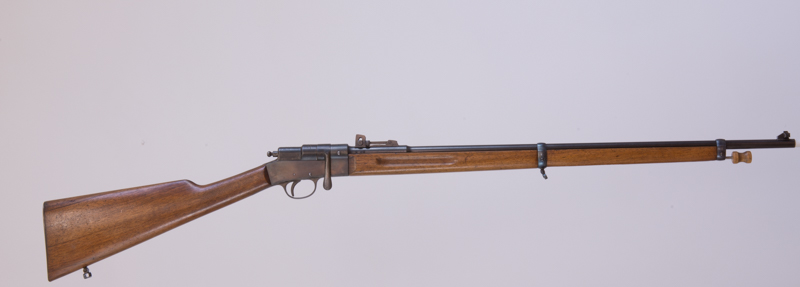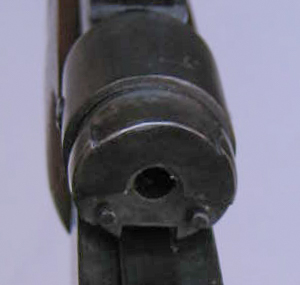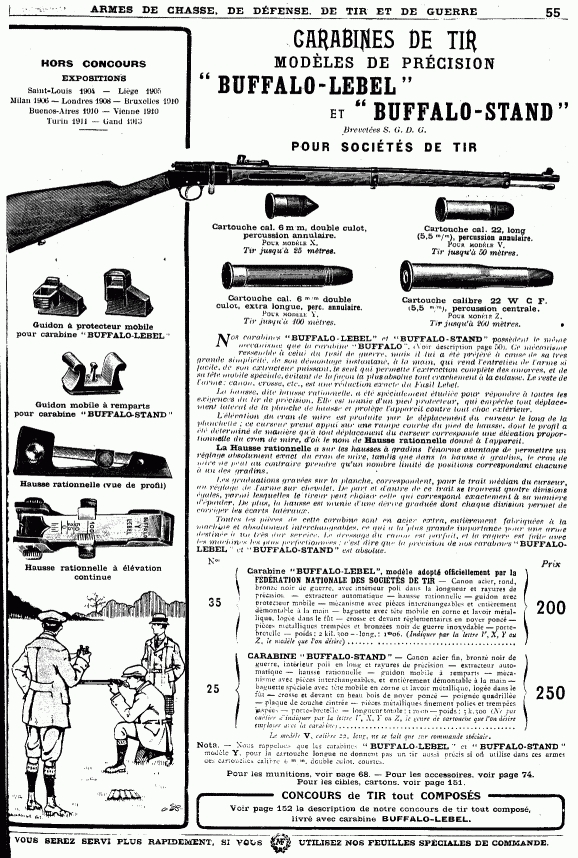See also the Lebel Training Rifle by Demay and the "Nationale" Cadet and Schools Rifle
or the fine Pidault Lebel model plus two more Lebel style Training Rifles
This model, as intended, bears a resemblance to the French Lebel Service Rifle
The next two images can be rotated and zoomed, either as initially loaded or full-screen for higher definition.
DATA TABLE - ALL MEASUREMENTS AS VIEWED |
||
FIREARM |
IMPERIAL |
METRIC |
| Designation or Type : | Military Style Cadet Rifle |
- |
| Action Type : | Turning bolt |
- |
| Nomenclature : | Carabine "Buffalo-Lebel" |
with serial no. |
| Calibre : | .22RF Long Rifle |
- |
| Weight : | 5 lbs. 4½ ozs. |
2.40 kgs |
| Length - Overall : | inches |
cms |
| Length - Barrel : | inches |
cms |
| Pull : | inches |
cms |
| Furniture : | Walnut |
- |
Rifling - No./Type of Grooves : |
6 - square cut |
- |
| Rifling - Twist : | 1 turn in 15¾ inches - RH |
1 : 40 cms |
| Rifling - Groove width : | inches |
mm |
| Rifling - Land width : | inches |
mm |
Rifling - Groove depth at muzzle : |
inches |
mm |
| Sight - Fore : | - |
|
| Sight - Rear : | - |
|
| Sight - Radius : | inches |
cms |
The somewhat unorthodox design of the action is well illustrated below.
The bolt body is mounted on a circular sectioned sliding bar that has an accommodating upper groove for the extractor;
itself more of a shotgun design than the equivalent small-bore rifles of the day.
The bolt bar engages in a circular groove machined in the receiver.
Both the bar and extractor slide forward underneath the barrel's breech.
The bolt is forward locking, which is achieved by the internal lugs, within the frontal sleeve of the bolt, engaging with the slots machined circumferentially around the breech face - and visible in the image below.
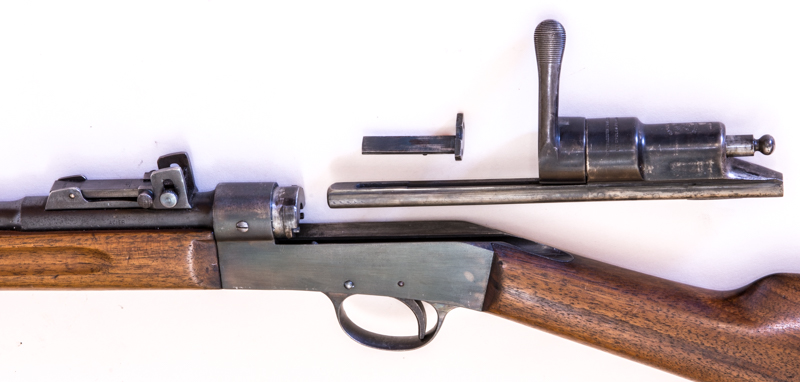
Below is the rifle shown on a page from Manufrance's 1913 catalogue.
The Buffalo-Lebel rifle is shown below along with the Populaire-Scolaire model in the Manufrance 1925 catalogue,
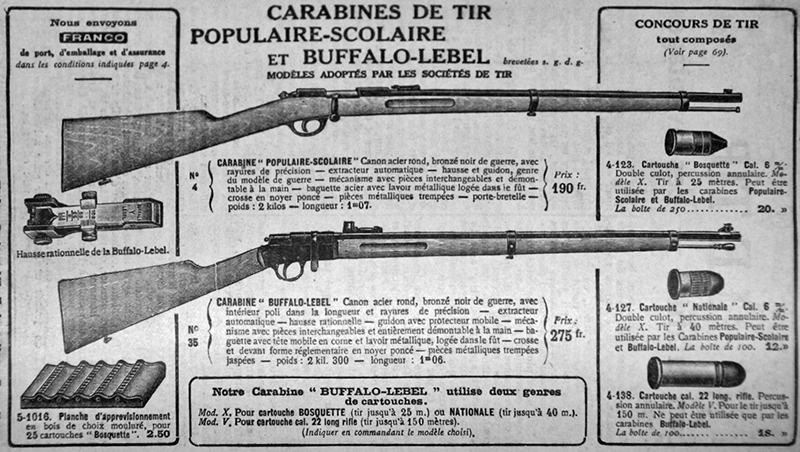
The "Double Culot" (double base) 6mm 'Bosquette' cartridge is illustrated with its conical bullet. The ammunition was then priced at 15.50 francs per 250 rounds, and the rifle at 275 francs; this when 1 franc was approximately the equivalent of 3.5p. Thus the rifle cost £9.63, and the ammunition about 54 new pence - or around a fifth of a decimal British penny - per round. [Ed: For a retired Brit., it rather goes against the grain to use the obviously plural noun ' pence' to describe a singular new penny!]. The Buffalo-Lebel was significantly more expensive than the accompanying "Populaire-Scolaire" Carbine indeed by a factor of practically 45%.
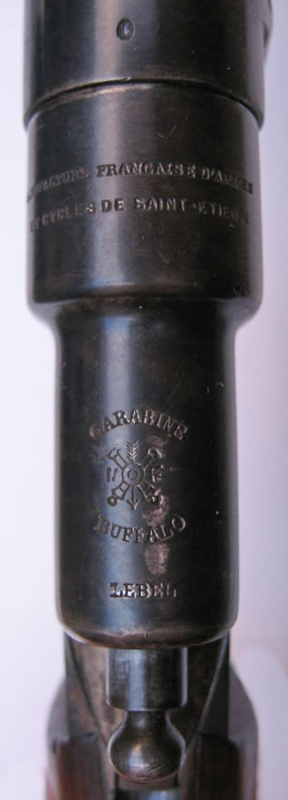
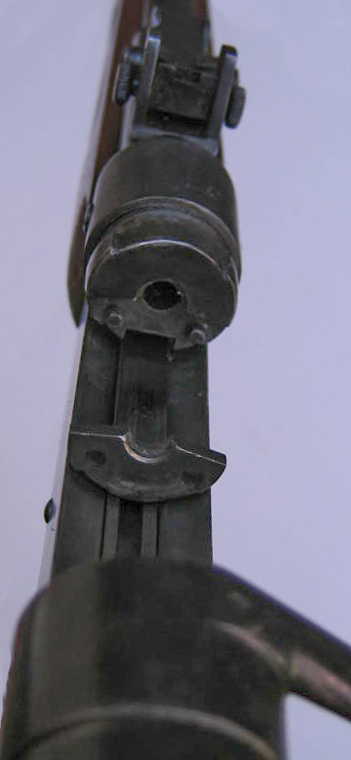
The full name of the well-known French manufacturer
is stamped on the bolt's breech shroud,
and the rifle's name on the bolt body
"MANUFACTURE FRANCAISE D'ARMES ET CYCLES DE SAINT-ETIENNE"
often afforded the sensibly and officially shortened trade name of
"MANUFRANCE"
To the right is shown the bolt-way with extractor, which is unusually located on a
slider which locates forward in a groove that runs beneath the breech, rather than
rearwards under the bolt body as is more commonly seen.
Rotation of the extractor "forks" is prevented by a pair of pins on the recess in the face of the breech,
which pins firmly locate the extractor.
The reduced diameter of the rear part of the barrel reinforce is shrouded
by the bolt-head when the bolt is closed, thus both shielding the firer from gas escape
in the event of a split cartridge case,
and centralising and locking the frankly rather loosely running bolt and extractor.
Below: the action and extractor are viewed from above.

and the barrel stamping
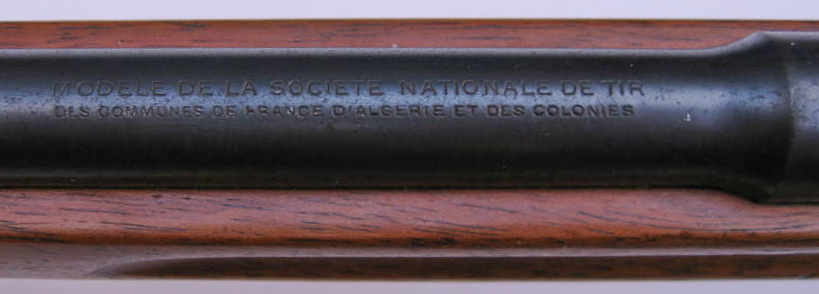
As the barrel marking indicates, this rifle was produced for, and specifically adoped by, the then French National Shooting Federation,
the " Fédération Nationale de Sociétés de Tir".
This was a situation equivalent to that which applied in the U.K, with British rifles manufactured or converted especially for our then Society of Miniature Rifle Clubs.
As can be seen, the Société de Tir then covered all France, Algeria and the Colonies.
The rifle was also earlier advertised, in the 1906 Fry's Compendium, alongside the contemporary Martini Francotte Cadet Rifle.
Both rifles were offered for sale by Martin Pulvermann & Co., of The Minories in London, which company was the Sole Agent for Great Britain and Ireland.
The Buffalo carbine is noted as complying with the regulations of the Society of Miniature Rifle Clubs.
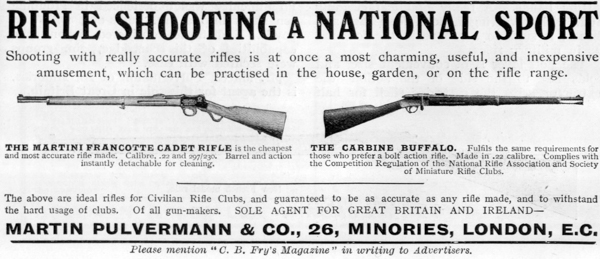
For those whose French language capabilities have deserted them over the years, the cartridges recommended for the "Buffalo-Lebel and Buffalo-Stand" were the 6mm Flobert of the Bosquette system - with conical bullet - intended for ranges up to 25 metres, and the similar 6mm "Nationale" cartridge, also double-based and 'percussion annulaire' (rimfire) - with round-nosed bullet -for ranges up to 40 metres. The Buffalo-Lebel was also available chambered for the .22RF Long-Rifle cartridge, which here has a stated maximum suitable range of 150 mtrs.
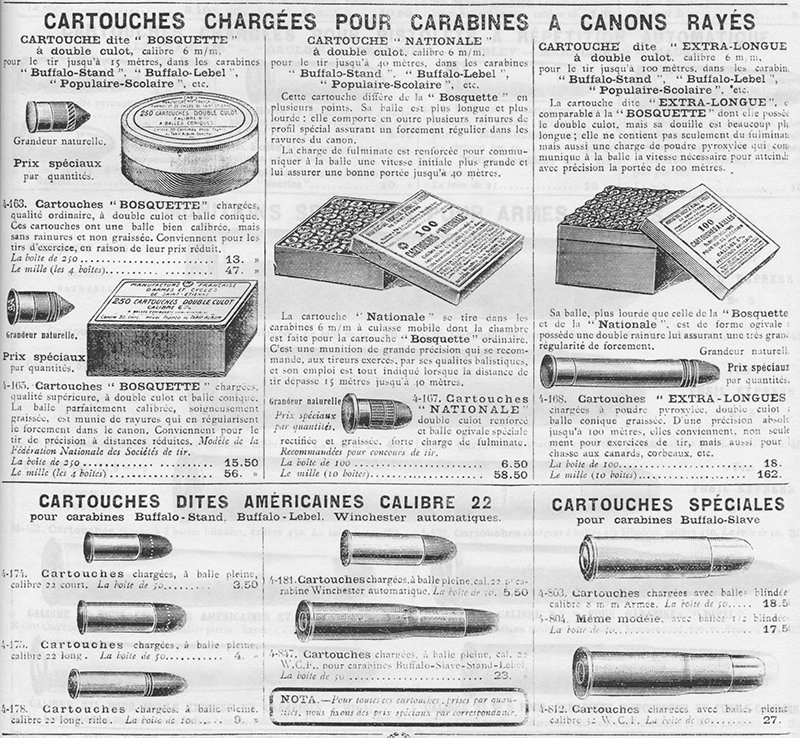
The rear-sight has a calibrated elevation slide that runs along the elevating ramp on the sight's barrel mount.
It is also fitted with a fine windage adjustment slide.
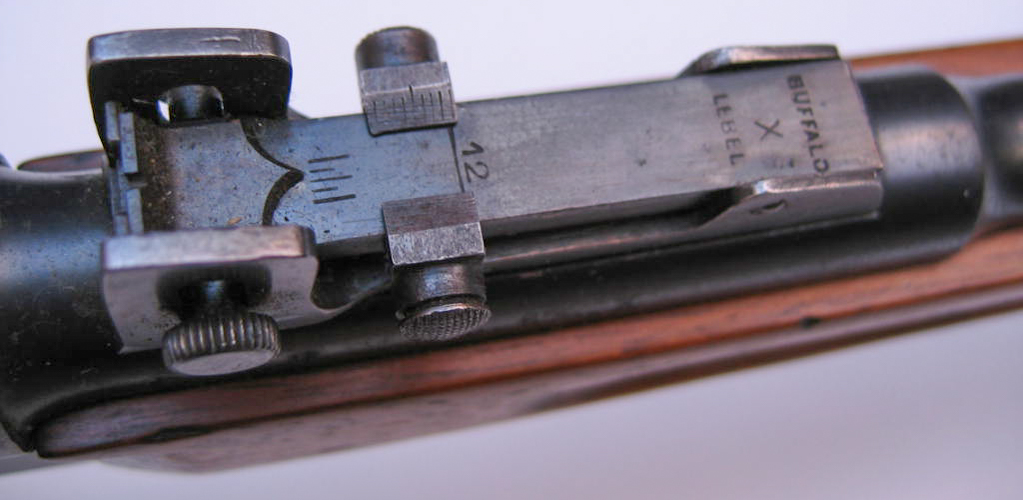
Below: the two opposed front locking lugs can just be seen inside the front of the bolt sleeve
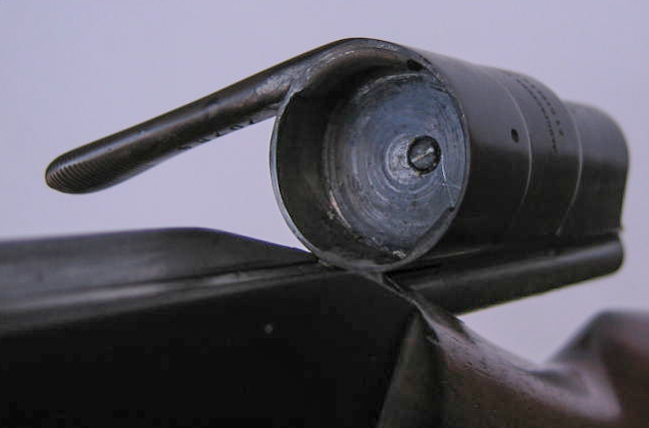
Three images of the breech, muzzle and rifling are shown below.
CLICKING ON THE CENTRE IMAGE WILL SHOW
A SHORT VIDEO CLIP OF A PASSAGE THROUGH THE BORE
Below is an image of a lead slug - in the form of a .22 bullet - that has been passed through this barrel.
The very slightly slanted indentation from a land is in the centre, and the compression of the bullet in the grooves can be seen either side,
where it is just possible to discern the original twin peripheral rows of indentations which held lubricant on the driving band.
See the Measurements table above for dimensions
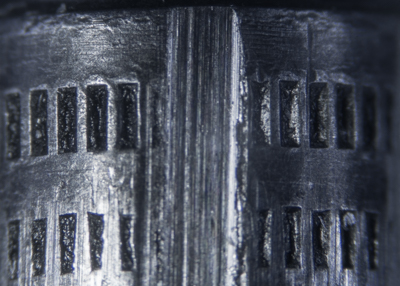
< land impression >
The lubricant indnts are barely touched by the rifling grooves, indicating a comparatively loose fit, as suggested by the measurements given in the earlier data table.
As with the Carabine Populaire-Scolaire from the same stable, the Buffalo action was also utilised in a range of pistols.
A 1913 advertisement for these is shown below.
Prices for these pistols were remarkably close to those for the rifles, and the finely engraved Hercule model was significantly more expensive.
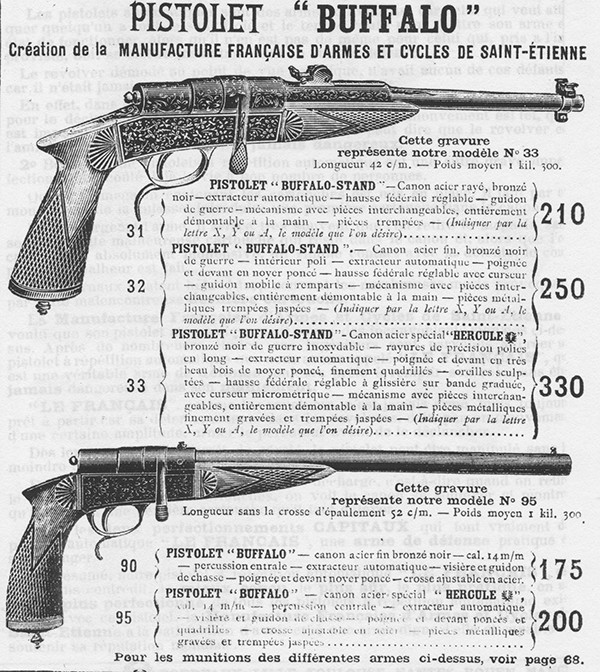
The Manufrance factory at Saint-Etienne
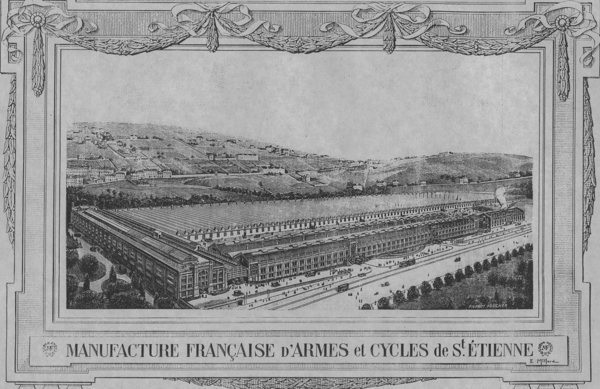
Manufrance started as a sporting goods mail-order company in 1885. By 1893 they were producing fishing tackle, at the same time as construction of the above new factory had begun. In October 1887, as the "Manufacture Française d'Armes", they patented their "Ideal" Rifle. With the invention of the bicycle, the company produced their own using the name "Hirondelle". By 1901 the company name became as shown in the illustrations, the wording "et Cycles" also having been added. In 1904, the company were manufacturing their own ammunition, and by 1906 a range of sewing machines had been introduced.
The Company's Paris outlet
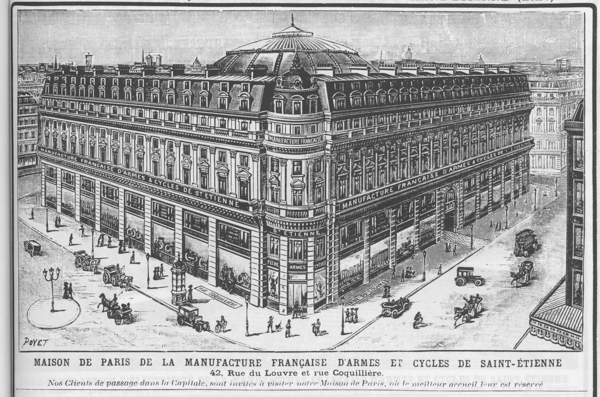
At the date of this catalogue, immediately before the First World War in 1913, the company, that had become "Manufrance" two years earlier, boasted retail outlets in Paris, Marseille, Lyon, Bordeaux, Lille, Toulpuse, Nantes, Rouen and Nancy. By 1973 the outlets number had increased to 64; but, after almost a hundred years of successful operation, bankruptcy was announced in 1980, and liquidation took place in 1985.
A contemporary of the British War Office Pattern 1906 Minature Rifle, the "Buffalo" Lebel was marketed first, but stood little chance of significant inroads into that market with the tremendous publicity building for the imminent release of the War Office approved rifle. The Lebel did sell in small numbers though.
The Lebel-like training rifle was produced by the " Manufacture Francaise D'armes et cycles de Saint-Etienne ( Loire)"
as the "Modele de la Societe Nationale de Tir", and thus was the direct French equivalent of our War Office rifle.
The Societe Nationale de Tir was the French combined equivalent of the British
National Rifle Association and the Society of Miniature Rifle Clubs
The 6mm calibre of this rifle is all but identical to the .22 rimfire cartridge at 5.5 mm, which the rifle happily chambers and fires with reasonable accuracy.

The clearing rod with this rifle is of similar configuration to, but, with its shorter length and overlarge wooden handle differing from the smaller ovoid one pictured on rifles elsewhere, may well be a replacement for the original.

Below is a facsimile of the Model 1886 French service rifle, taken from the British 1904 'Text Book of Small Arms' (Plate No. XXIII), to which the Buffalo Lebel is an approximation,

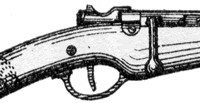
but with a bolt-handle configuration more akin to that of
the French Army's 1890 Mannlicher style carbine - right
A 1906 advertisement paid for by the sole British importers, Martin Pulvermann & Co., London, offered the "Carbine Buffalo" adjacent to a Francotte Martini Cadet rifle.
For the time, quite reasonably declaring rifle shooting as a National sport, they announce that " Shooting with really accurate rifles is at once a most charming, useful and inexpensive amusement, which can be practised in the house, garden, or on the rifle range". Evidently British houses and gardens were bigger in those days, and the language rather more flowery!
The Francotte was described as "the cheapest and most accurate rifle made. Calibre., .22 and .297/.230. Barrel and action instantly detachable for cleaning". The Birmingham Small Arms Company may well have had something to say about this, for, even though their own Martini rifles were based on the Francotte action, many International records were being made by those shooting with B.S.A. rifles. Pulvermanns were flying in the face of a very strong opposing wind, although we have yet to discover the then cost of the Francotte to compare it with the B.S.A. models then on offer. ( see the 1908 B.S.A. catalogue as a PDF)
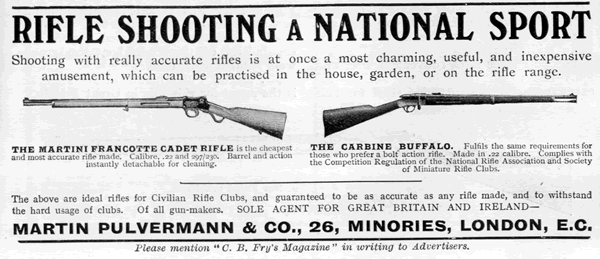
The name "Carbine Buffalo" was not the best translation of the French " Carabine Buffalo-Lebel" title for the rifle.
At 42 inches in overall length, this rifle was only two and a half inches shorter than the British SMLE service rifle which had been introduced only three years earlier. This hardly put the rifle in the carbine category. Even the .577 calibre Snider Cadet rifle, a training version of the cavalry carbine, was only 37 inches in length.
In July of 1906, C.B. Fry - in his famous monthly sporting journal, Fry's Magazine - covered the arrival into the U.K. of the Lebel. It thoroughly described the rifle, at the same time drawing obvious comparisons with the War Office Miniature Rifle, and was worded as follows
A NEW RIFLE

"IN view of the enterprise exhibited by the British War Office in the development of a standard pattern low-power rifle, it is interesting to record that the first movement of this kind originated with our neighbours the French, who as long ago as 1893 developed a reduced model of the Lebel Rifle especially for the purpose of instructing boys in the State primary schools in the rudiments of marksmanship.
French riflemakers, beyond being guided by certain principles to which rifles officially approved for the purpose must conform, have been allowed to modify and improve the details of the original pattern. The result of free competition has been the production, at St. Etienne, the home of the French rifle industry, of a new model shooting the .22 calibre rim fire ammunition. In general outline it is remarkably similar to our War Office reduction of the British Lee-Enfield, but, it must be reluctantly admitted, incomparably better constructed and finished than the samples of the latter which have hitherto been available for inspection.
Our illustration will convey an idea of its symmetrical appearance. The effective length of the barrel is 26ins. The stock is of walnut, and the fore end extended nearly to the muzzle, and finished with neatly fitting bands. A really practical cleaning rod, with revolving handle, loop jag, and brush, is sunk in a groove in the fore-end as in military rifles.
The bolt lever is of convenient size, and folds fiat to the side of the action—the extractor grips the cartridge shell for half its diameter and completely withdraws it. The stock from butt to trigger is 14ins. in length, the distance between front and back-sight is 23ins., and from eye to back-sight 8ins. The weight is 5lbs. 6ozs., or 1oz. heavier, and the length 41¾ ins., or ¼in. longer, than the British model.
The barrel has six grooves with rounded edges, making about one turn and a half in the length of the barrel, a pitch which has been found in practice to give excellent results with the .22 calibre short cartridge.
The bolt may be completely withdrawn by pressing the trigger forward whilst pulling the bolt lever in the reverse direction. The bolt-head passes like a sleeve completely over the breech end of the barrel, and has internal lugs which engage rigidly into a groove in the barrel. Complete obturation of the breech has always been difficult to secure with low-power rim fire ammunition, but any backward escape of gas is quite impossible with this arrangement.
The fore-sight is a substantial bead of good shape, fitted into a dovetail groove, and permitting of lateral adjustment. The back-sight is of the ordinary tangent military pattern, with a somewhat deeply cut notch.
Its accuracy is equal to the best possibilities of the .22 short cartridge. At 25yds. no difficulty was experienced in grouping ten shots into a lin. bull's-eye, whilst at 5oyds., a distance considered beyond the capabilities of this cartridge, 2in. groups were secured with ease.
Mr. Martin Pulvermann, of 26, Minories, is the agent for this rifle in Great Britain."
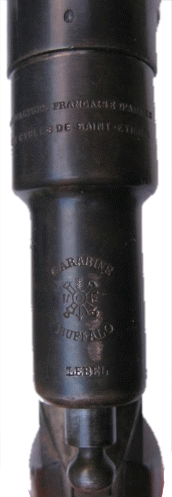
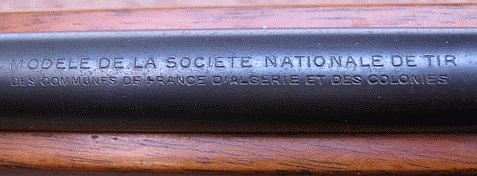
Left, the barrel is impressed with theauthorising French National Shooting Society , the extensive jurisdiction of which evidently covered France, Algeria and the French Colonies.
It is of interest to note the parallel introduction of the French "official" training rifle and the British War Office model.
The images on the lower section of the page well illustrate the unusual slide bolt-action an rotating handle locking sytem.

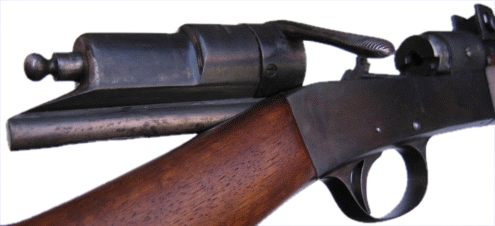
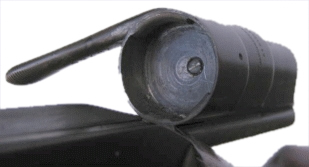
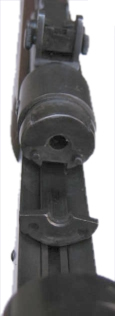
The massive bolt-head shrouds the breech. The off-set rim-fire firing-pin can be seen clearly in the broad face.
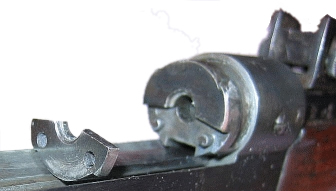 .............. The sliding extractor is vulnerable and prone to breakage or jams.
.............. The sliding extractor is vulnerable and prone to breakage or jams.
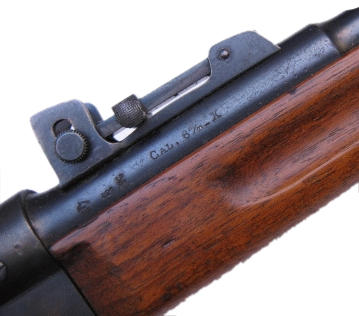
..............The calibre and proof marks are on the barrel's RHS below the substantial and effective rear-sight,
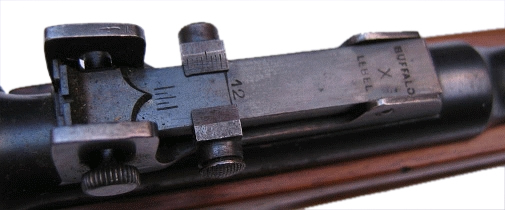 ..............which incorporates a fine windage adjustment.
..............which incorporates a fine windage adjustment.
We illustrate below the page from the French catalogue for the Manufacture Francaise D'armes et cycles de Saint-Etienne.
The "Lebel" rifle then sold for 200 French francs, with a Stand sporting model at FF250.
The eagle-eyed reader will have spotted the similarity between the fore-sight fitted to the Lebel and that of the British War Office Pattern Miniature Rifle. They appear to be one and the same!
However, the advertisement for the rifles imported into Britain shows only the dovetailed bead described in Fry's Magazine. The French catalogue is, though, several years later, evidenced by the reference to concours expositions as late as 1913 immediately previous to the Great War.
The rifle appears to be available in .22 Long, a 6mm saloon round for short range, a 6mm long Flobert type cartridge for up to 100 mtrs., and the Winchester .22 centrefire cartridge, which takes the useful range out to 200 mtrs.
The latter cartridge was designed for use with another contemporary rifle purchased by the War Office for the Royal Flying Corps and the Royal Air Force (as of November 1917) for training aviators in shooting the Vickers machine gun in aerial combat. See the 1903 Winchester semi-automatic rifle.
One of these rifles recently came up for sale in the U.S. with an asking price of $750. It was described as a
"Fascinating, although not very reliable little rifle on which the action needs 'adjustment'."
It does appear to be fitted with the War Office Miniature Rifle fore-sight - or was the War Office Miniature fitted with a French fore-sight? The sight is certainly shown as a component on the Enfield Drawings for the British rifle, but may still have been to a French design. Or were matters the other way around? Chickens and eggs come to mind.
BSA certainly patented a foresight with an integral hinged protecting hood, but that patent - No 9262 of April 1906 - showed the hood hinging fore-and-aft rather than the athwartships orientation seen on most production models and in the above French advertisement. (See this patent on the page for the War Office Pattern Miniature Rifle).

This image shows just how close the tangent rear-sight was set to the rear, immediately in front of the action. Such short eye relief over open sights would not suit an older shooter, and the rifle was obviously intended for young eyes.

See also the Lebel Training Rifle by Demay
and Two more Lebel Training Rifles

